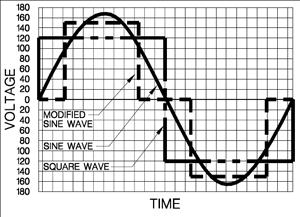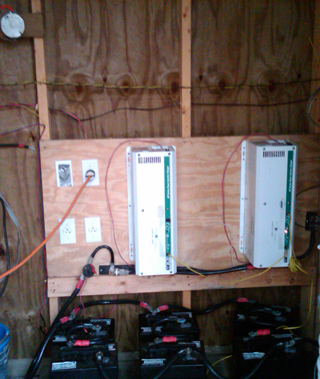Living Off The Grid
In West Branch Michigan
Electrical Conversion
Introduction
At this point you have generated power from a photovoltaic panel or wind turbine. You've stored any extra power into a battery array for use during periods of low wind and darkness. Now you need to convert that energy into something that is useful. While you can use the DC power off the batteries directly, you will not be able to use normal every day appliances because they are based on alternating current (AC) rather than the direct current (DC) delivered from the batteries. In order to use these appliances you will need to convert the 12V DC power into 120V AC power. You use a device called a Power Inverter to accomplish this task.
 There are three types of wave-forms an inverter can use to convert a DC signal into AC.
These wave-forms are the Square Wave, Modified Sine Wave, and the Pure Sine Wave.
Most AC appliances will not work with a square wave waveform, however most appliances will
work with a Motified Sine Wave waveform. This includes motors and pumps which requires a
large startup current surge. Pure Sine Wave inverters produce a waveform that is exactly
like the power you get from the electric company. Due to the additional features to make a
pure sine wave, these inverters are more expensive than modified sine wave inverters.
There are three types of wave-forms an inverter can use to convert a DC signal into AC.
These wave-forms are the Square Wave, Modified Sine Wave, and the Pure Sine Wave.
Most AC appliances will not work with a square wave waveform, however most appliances will
work with a Motified Sine Wave waveform. This includes motors and pumps which requires a
large startup current surge. Pure Sine Wave inverters produce a waveform that is exactly
like the power you get from the electric company. Due to the additional features to make a
pure sine wave, these inverters are more expensive than modified sine wave inverters.
Some inverters have chargers built into them for easy convenience. This way one unit can do two functions. 1) the inverter acts as a normal inverter and converts DC power to AC power; and 2) it also acts as a battery charger so you can charge your batteries from an external source like a gasoline generator or from the electrical company. When the inverter is in the charge mode it will pass on the incoming AC power from your generator directly to your AC loads at the same time it is charging your batteries.
Most inverters provide 120VAC power. However if you need to drive a 220VAC motor like a well pump then you need to make sure your inverter can be "stacked" with another inverter to increase the output voltage. Your other option is to install a step-up transformer to convert the 120VAC power from the inverter to 220VAC.
My System
In my system I chose to use two inverters to power my 120VAC cabin needs as well as my 220vac
well pump. I purchased a set of inverters that I could "stack" together. I drive
my cabin from the output of the first inverter and the well pump uses both inverters when it
cycles on.

My entire system is installed in an out-building near my cabin. In that building I have my
battery system, charge controllers, and inverters. I made it easy to remove any one
component for maintenance purposes and the building is built tight to prevent the outside
elements from affecting thre operation of my system.

Links
Below are some links where I did my research on Inverters.
- DonRowe.com
- Frequently Asked Questions about Power Inverters
- Xantrex
- Inverters for Industrial and Renewable Energy Systems